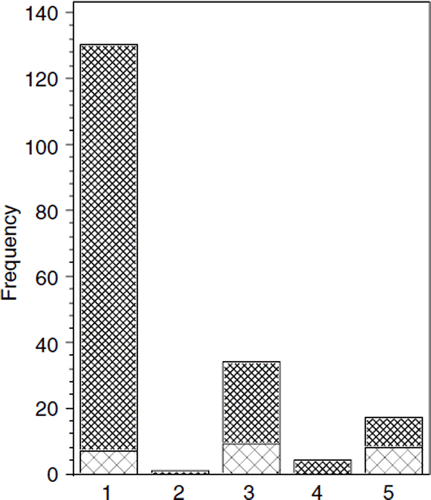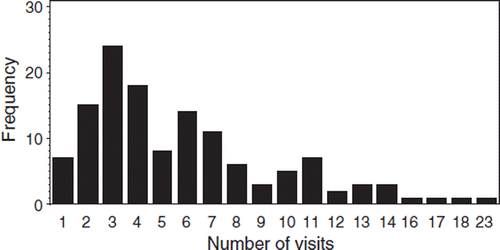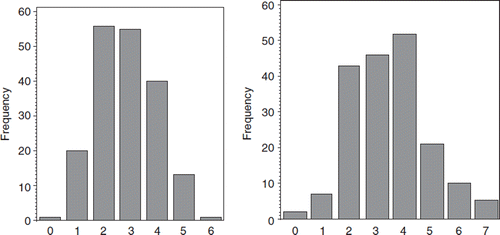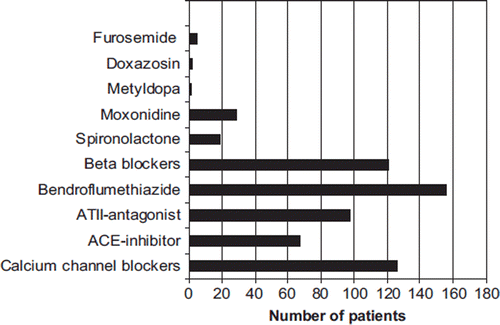Abstract
Aims. This manuscript presents results from 4 years experience in a nurse-led hypertension clinic. The aim of the hypertension clinic was to optimize hypertension treatment and to reduce the number of physician consultations. Materials and methods. All patients were initially examined by cardiologists. All follow-up visits were performed by nurses. They initiated and titrated antihypertensive medication according to a stepwise treatment algorithm or the physicians' instructions. The blood pressure (BP) measurement technique and the recording of risk profile were performed as instructed by guidelines from the European Hypertension Society. Results. During the first 4 years, 186 patients were treated in the hypertension clinic. One hundred and thirty patients were treated by the nurses alone and hereafter discharged to general practitioners; 95% of these patients reached target BP. Most of the patients received combination therapy with two to seven different antihypertensive drugs. The three primary antihypertensive drugs (calcium-channel blockers, angiotensin-converting enzyme inhibitors/angiotensin receptor blockers and diuretics) were the first drugs to be used and they made up the main part of the combination therapy. Conclusion. In spite of many risk factors, co-existing cardiovascular diseases and severe hypertension, 95% of the patients achieved target BP when treated in a nurse-led hypertension clinic. We suggest that the data serves as an inspiration for other clinics and GPs to implement the concept.
Key Words::
Introduction
Several epidemiological studies show that most of the treated hypertensive patients fail to meet the target goal (Citation1–4). It is essential to develop a patient care system that is able to treat patients to target blood pressure (BP) goal and maintain the goal. Many elements in a hypertension organization have been evaluated in a recent Cochrane report (Citation5) that aimed to find the best system to organize patient care in hypertension. The Cochrane report concluded that an effective organization has not yet been identified. They pointed to the nurse-led clinics as a possible solution that needs further evaluation.
The nurse-led hypertension clinic in Holbaek started in 2004. Patients with very advanced and complicated hypertension were treated here. It was based on standard treatment according to the European guidelines (Citation6) with the following important elements: patient commitment, awareness, compliance and education of the patient, a stepped-care approach according to a treatment algorithm, control of side-effects, adherence to target goal and intervention against other risk factors.
This paper is a report of the results from 4 years experience in the nurse-led hypertension clinic. The aim of the report is to bring more evidence on the efficacy of nurse-led hypertension clinic and to spread the concept of hypertension clinics to other internal medicine departments and to GPs.
Materials and Methods
Design and resources
The hypertension clinic started in 2004. Two experienced nurse specialists took responsibility for the ongoing management of the hypertensive patients. The nurses were trained in hypertension pathophysiology, epidemiology, in non-pharmacological treatment and in antihypertensive treatment. The education was given in 20 lectures by senior consultants in the division of cardiology.
At the first contact, a cardiologist who initiated treatment and planned an examination programme saw the patients. Hereafter the nurses took responsibility for the ongoing treatment until the patients reached target goal and were referred to general practitioners. Results from all patients that finished treatment during the first 4 years of work in the hypertension clinic are included in this report (n=186).
A treatment algorithm served as foundation for the stepwise increments in treatment (). According to the treatment algorithm, all patients started treatment with amlodipine. Angiotension-converting enzyme inhibitor/angiotensin receptor blocker (ACE-I/ARB) and thiazide were the second and third agent in the combination therapy. Exceptions were made if the patients were diagnosed with ischemic heart disease (IHD) or if the patients previously experienced side-effects to amlodipine. Alternatively, the cardiologist planned another treatment. After each visit in the hypertension clinic, the cardiologist approved the nurses' notes in the patient record. If necessary, the cardiologist examined the patients upon the nurses' request.
Table I. Algorithm for stepwise medical treatment in the nurse-led hypertension clinic.
The nurses informed the patients about hypertension, cardiovascular (CV) risk factors and the current list of medicine. Topics like compliance and side-effects were important in the education of the patients.
The nurses scheduled the first visit to 50 min. The following visits were scheduled to 20 min. The interval between visits was scheduled to 3 weeks. Se-creatinine and se-potassium were checked regularly, if the use of antihypertensive medicine necessitated control.
If an assessment of coronary risk defined a high-risk level, the patients started treatment with statins. Eight weeks after start of statins, the lipids, liver function and creatine kinase were controlled. If indicated, the patients started treatment with acetylsalicylic acid (ASA) when the BP level was under control. Some of these patients [stroke patients or post-myocardial infarction (MI) patients] started taking ASA before admission to the hypertension clinic.
The nurses informed the patients about necessary changes in lifestyle including smoking cessation. Eighteen of the patients consulted a dietician. Upon reaching the target BP goal, the visits in the hypertension clinic stopped and the patents were discharged to the GP. Thus the patients were discharged without taking into account the target goals in body mass index (BMI), cholesterol and other risk factors.
All patients were examined with electrocardiography and echocardiography. Renography was performed in 32 of the cases. If indicated, the cardiologist planned a detailed examination programme for secondary hypertension.
Measurements
BP measurements were performed using a standard mercury manometer and an appropriate cuff. In the first measurement setting, two measurements were performed to decide which arm had the highest BP. In the next and subsequent BP measurements, the nurses measured three BPs and the mean value of the two last BPs was recorded. BP was measured with the patient in the sitting position after 5 min of rest. If white coat hypertension was suspected, a 24-h ambulatory BP was performed in the Clinical Physiological Department (Boso TM 2430). Some patients preferred home BP measurements. These patients used semi-automatic electronic equipment (A&D UA 767, OMRON M4-1 or OMRON M6). The equipment was validated against a standard mercury manometer. Target goal was 140/90 mmHg and 130/80 mmHg for diabetics. When using 24-h ambulatory BP or home BP, the target goal was 135/85 mmHg and 130/80 mmHg for diabetics (Citation6).
Non-fasting low-density lipoprotein (LDL) was measured. Height and weight was measured and BMI calculated. The following information was reported in the patient record: history of family disposition, use of tobacco and medicine. Physical activity was not recorded as an outcome parameter but all patients were encouraged to physical activity. The risk profiles of the individual patients were calculated according to the recommendations of the European Hypertension Society (Citation6).
All the patients were informed about the treatment system and consented. The data were collected prospectively.
Statistics
The results were described using relative frequencies and mean values. Comparisons of values at the start and at the end were performed with a non-parametric test (Wilcoxon signed rank test). A p-value<0.05 was considered significant.
Results
Baseline characteristics are given in ; 110 men and 76 women were treated in the hypertension clinic. The mean age was 61.1±13.0 years.
Table II. Baseline descriptive data.
Risk profile
All patients scored moderate to very high values in risk scores: 33.3% were in risk group 2 with 15–20% risk of CV events in 10 years, 10.2% were in risk group 3 with 20–30% risk of CV events in 10 years and 56.5% were in risk group 4 with more than 30% risk of CV events in 10 years (). Just over half (53.3%) had left ventricular hypertrophy verified by echocardiography and 7.5% had persistent atrial fibrillation.
Figure 1. The hypertension patients were divided into five groups by way of status at the end of treatment in the hypertension clinic. (Citation1) Finished the stepwise medicine increment in the hypertension clinic; (Citation2) died before finishing the programme; (Citation3) referred to Cardiological Outpatient clinic; (Citation4): referred to other outpatient clinic; (Citation5) patients withdrew from the hypertension clinic. The fraction of successfully treated patients is shown in dark areas. The fraction of patients that did not reach target goal is shown in light areas (n=186).

Treatment period
One hundred and eighty-six patients were discharged from the hypertension clinic before January 1, 2009 (); 130 (70%) finished the stepwise titration of antihypertensive medicine and were hereafter referred to the GPs; 34 (18%) had concomitant cardiological or renal diseases and were referred to outpatient clinics in cardiological or nephrological departments; 28 of these patients had reached target goal when referred to the outpatient clinic; 17 (9%) chose to stop treatment in the clinic, and eight of these patients did not achieve target goal. This decision was often based on long distances and transport problems. One patient died before discharge. Fifty percent had finished the stepwise medicine programme in four visits or fewer (6.5 months); 75% finished after six to seven visits or fewer (11 months). A few needed more visits (max. 23 visits) (). The number of physician consultations substituted with a nurse visit are approximately 600–700 visits.
Figure 2. The majority of the patients need only a few visits before finishing the stepwise medicine programme. The right skewed graph shows that half of the patients finish after four visits or before; 75% of the patients need six to seven visits or fewer. Only a few patients need many visits (maximum 23 visits).

Treatment successes
In the group of patients that finished the stepwise titration of antihypertensive medicine in the clinic (n=130), mean systolic BP decreased from 168.6±20.1 mmHg to 134.2 mmHg) (p<0.0001) and diastolic BP decreased from 93.3±93.0 mmHg to 78.8 mmHg (p<0.0001). Forty-eight of the patients did not reach target goal when checked by clinical BP only. These patients were checked with home BP measurements or ambulatory BP to assess the white-coat effect. Hereafter, 95% of the patients reached target goal. Only seven of 130 patients finished the hypertension clinic with BP higher than target. LDL decreased from 3.1±3.1 mmol/l to 2.5 mmol/l (p<0.0001). Nobody stopped smoking. Nine lost weight (>5 kg). There was no significant increase in se-creatinine.
Antihypertensive therapy
The therapy was based on an algorithm for stepwise titration of antihypertensive medicine (); 95% of the patients needed a combination of two to seven different pills (). At the first visit, the mean number of antihypertensive therapeutics was 2.8. At the end, the mean number was 3.5. Half of the patients were treated with the combination ACE-I/ARB, calcium-channel blockers and thiazide. Thirteen were on a treatment that included “dual-blockade” with ACE-I and ARB; 67% were treated with calcium-channel blockers in mono- or combination therapy (). In 39% of the cases, the final medication included ACE-Is; 53% took ARB; 83% took thiazide and/or a combination tablet with hydrochlorthiazide; 11% took spironolactone; 13% took moxonidine; and 66% took beta-blockers. Forty-five percent were treated with ASA and 71% were treated with statins.
Figure 3. These two graphs show the number of antihypertensive agents used at visit 1 (left) and at the final visit (right) in the hypertension clinic. The number of agents at the last visit is only slightly higher that the number of agents at the first visit (n=186).

Figure 4. Calcium-channel blockers, angiotensin-converting enzyme inhibitor (ACE-I; or angiotensin II-antagonist) and bendroflumethiazide were the three main antihypertensive agents. Because of severe hypertension and many complications, a large part of the patients received beta-blockers. Spironolactone and moxonidine are next in line. Very few patients need the agents at the top of the list.

Discussion
The implementation of a nurse-led hypertension clinic was performed with satisfactory patient outcomes. It has reduced physician workload and probably cost while maintaining quality of care. The number of blood tests was in accordance with the guidelines in our division. According to the protocol, there was no use of more tests or investigations than in a physicians clinic. It may be argued that quality of care improved because the number reaching target goal was by far higher than reports from epidemiological studies over treated hypertensives (Citation1–4).
The nurses provided longer consultations [50 min (first visit) and 20 min (next visits)] than in a physician's clinic (15 min). However, because of differences in salary, total costs may be lower in a nurse-led hypertension clinic.
Several other nurse-led hypertension clinics have reported their results. Some nurse-led clinics control BP measurements only, and the physicians continue to control the decisions on medicine (Citation7). In other hypertension clinics, the nurses take responsibility for the ongoing management of patient care including medicine and in some clinics even the prescription of antihypertensive medicine (Citation8–10). The results from nurse-led clinics point to important advantages. The most important ones are the efficacy in BP outcomes, safety and reduction in the physician's workload. One study has calculated that nurse-led clinics are cost-effective (Citation11).
In contrast to the above-mentioned hypertension clinics, the nurse-led clinic in Holbaek managed care to severely hypertensive patients with a high risk factor level and with complicating diseases. They were referred to the clinic because of uncontrolled hypertension, many risk factors and CV diseases such as IHD, left ventricular hypertrophy and atrial fibrillation. The risk factor level may have been underestimated because microalbuminuria was not systematically investigated in all patients. At the beginning, the target BP was 140/90 mmHg (135/80 mmHg for diabetics). The target goals have now been set lower and are currently 130/80 mmHg for post-MI patients and for stroke patients.
In spite of severe hypertension and a high-risk profile, the frequency of success in BP outcomes was high. Only seven of 130 patients did not achieve target BP goal. In these seven cases, the reason for persistent high BP level was side-effects to the antihypertensive medicine.
BP reduced markedly and the BP-attributable risk decreased both in the patients that reached target goal and in the patients that did not achieve target goal but were reduced in BP level as much as side-effects allowed. The risk factor level was assessed, and relevant treatment was started. Lifestyle interventions were initiated. There was a satisfactory result in LDL levels. There was almost no effect on overweight and smoking. The lack of success may be because the patients were relatively symptomless and therefore not motivated for lifestyle interventions. However, time limits in the hypertension clinic may also be responsible for the lack of success in the field of risk factors: half of the patients finished the antihypertensive programme within 6 months and that period is not enough to allow results in lifestyle interventions.
The stepwise algorithm for antihypertensive therapy included the three commonly used first-line agents (calcium-channel blockers, ACE-Is/ARBs and diuretics). These three antihypertensives were widely used and were the base of most of the combinations. Less than one antihypertensive was added to the mean number of antihypertensives during the time span from the first visit to the last visit (). This indicates that the first antihypertensives were very effective and that the following therapeutic was chosen carefully. It may also suggest an important improvement in patient compliance. Many were treated with ARBs instead of ACE-Is. Side-effects (cough) limited the use of ACE-Is. Seven percent received dual blockade with both ACE-Is and ARBs. Earlier that combination was considered acceptable but new data (Citation12) shows that it requires careful consideration.
Beta-blockers were widely used. They were included in advanced combinations for severe hypertension and were used in the treatment of post-MI patients.
Which element was the cornerstone of success in the nurse-led clinic? Is the success associated with effective combinations of medicine, with education of the patients, with compliance, with the nurse who persistently followed the goal, with the stepwise medicine programme and well-scheduled return visits? That question cannot be answered. However, the combination is effective. The nurse-led clinic is a concept that secures hypertension patients an effective treatment that reduces stroke risk and CV risk. We recommend that the concept be introduced in departments of internal medicine and in primary care. In primary care, the patients present milder hypertension and fewer risk factors and it is anticipated that they will need fewer return visits and fewer advanced combinations of medicine. In primary care, the patients may profit from a nurse that focus on hypertension. Thus, a nurse-led clinic may lead to better compliance.
Conclusion
The nurse-led hypertension clinic is very effective in bringing the patients to the target goal. In spite of advanced hypertension and many risk factors, the goal is achieved in relatively few return visits. The nurses initiated lifestyle intervention and cholesterol-lowering treatment. Thus, the impact of the nurse-led hypertension clinic on the patients' risk profile is considerable.
Declaration of interest: None for any of the authors.
References
- Hajjar I, Kotchen TA. Trends in prevalence, awareness, treatment, and control of hypertension in the United States, 1988–2000. JAMA. 2003;290:199–206.
- Sehestedt T, Ibsen H, Jørgensen T. Awareness, treatment and control of hypertension in Denmark. The Inter99 study. Blood Press. 2007;16:312–319.
- Kastarinen MJ, Antikainen RL, Laatikainen TK, Salomaa VV, Tuomilehto JO, Nissinen AM, . Trends in hypertension care in eastern and south-western Finland during 1982–2002. J Hypertens. 2006;24:829–836.
- Cífková R, Skodová Z, Lánská V, Adámková V, Novozámská E, Petrzílková Z, . Trends in blood pressure levels, prevalence, awareness, treatment, and control of hypertension in the Czech population from 1985 to 2000. J Hypertens. 2004; 22:1479–1485.
- Fahey T, Schroeder K, Ebrahim S. Interventions used to improve control of blood pressure in patients with hypertension. Cochrane Database of Systematic Reviews. 2006, Issue 4. Art. No. CD005182. DOI: 10.1002/14651858. CD005182.pub.
- Mancia G, de Backer G, Dominiczak A, Cifkova R, Fagard R, Germano G, . 2007 Guidelines for the Management of Arterial Hypertension. The Task Force for the Management of Arterial Hypertension of the European Society of Hypertension (ESH) and of the European Society of Cardiology (ESC). J Hypertens. 2007;25: 1105–1187.
- Schroeder K, Fahey T, Hollinghurst S, Peters TJ. Nurse-led adherence support in hypertension: A randomized controlled trial. Fam Pract. 2005;22:144–151.
- Pippa Oakeshott. Nurse-led management of hypertension. Br J Gen Pract. 2005;55:53.
- Denver EA, Barnard M, Woolfson RG, Earle KA. Management of uncontrolled hypertension in a nurse-led clinic compared with conventional care for patients with type 2 diabetes. Diabetes Care. 2003;26:2256–2260.
- New JP, Mason JM, Freemantle N, Teasdale S, Wong LM, Bruce NJ, . Specialist nurse-led intervention to treat and control hypertension and hyperlipidemia in diabetes (SPLINT): A randomized controlled trial. Diabetes Care. 2003;26:2250–2255.
- Mason JM, Freemantle N, Gibson JM, New JP. Specialist nurse-led clinics to improve control of hypertension and hyperlipidemia in diabetes: Economic analysis of the SPLINT trial. Diabetes Care. 2005;28:40.
- The ONTARGET Investigators. Telmisartan, ramipril, or both in patients at high risk for vascular events. N Engl J Med. 2008;358:1547–1559.